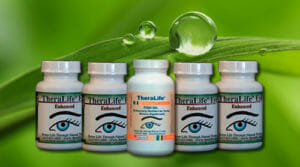Glare and Halos are common after LASIK.
One typical question patients often get when they go through LASIK eye surgery is – how can they get rid of their halos?
Undergoing LASIK can cause a complicated and unpredictable outcome and may not always be identical for all patients involved.
Seeing halos around lights is one of the most common symptoms after LASIK.
How Theralife can help
TheraLife® Eye accelerates and aids the healing of damaged corneal nerves and tissue.
It contains potent anti-inflammatory agents to reduce swelling and dry eye discomfort.
It stimulates tear glands to produce balanced and normal tears.
It speeds tissue recovery after LASIK surgery
Learn more from other TheraLIfe customers
TheraLife Has Worked The Best
I have chronic dry eye due to LASIK. My eyes are definitely better since I have been taking TheraLife capsules in combination with the fish oil. I also take flax seed oil twice daily.
Approx 6 weeks after my lasik eye surgery I developed severe dry eyes. (I had the operation in November of 2007.) I tried many products, and the one that has worked the best for me is TheraLife Eye. I have also forwarded your information to TLC (Toronto Lasik Clinic); they should be aware of products out there to help the many patients who experience dry eyes after surgery. I still have to use non-preservative eye drops during the day and gel at night…. but it’s definitely much less frequent since I have been using your product.
EM- United States
What are Glare and Halos after LASIK?
Glare or halos around lights is an odd color or glow that appears close to objects like bright circles. It’s possible to see them immediately.
But glare and halos can also be found in places on the eye.
Sometimes people have trouble focusing on bright light and even shiny objects in bright direct sunlight.
Halos and glares can cause eye pain but rarely vision loss.
Halos and glare appear right after Lasik and are common side effect.
People with higher prescriptions have more issues with glare and halos.
What are halos after LASIK?
Seeing halos around lights temporarily affect your vision after LASIK due to changes to your eye’s surface.
You’re likely seeing them in the evening after LASIK.
Halos around lights also tend to appear more commonly at night. They look like bright circles around bright lights such as street lights and headlights, regardless of light sources.
Seeing halos around lights can be expected.
Although most LASIK patients consider the halo effect a “side effect”,- it is not necessarily a side effect.
Instead, halos around lights can indicate that your eyes are starting to recover, a part of the healing process.
It’s primarily because the liquid in your cornea accumulates, which results in swelling.
What causes glare and halos after LASIK?
Refractive error causes them.
Halos around lights usually appear in low light conditions, such as driving at night.
Glare occurs during daylight hours which is a normal response to bright light, but other causes may cause them, such as cataracts.
A cataract is a cloudy lens caused by UV damage or aging. It is easy for light entering and travel through. Expect glare in your eyelids.
Cataracts scatter light rather than concentrate it. It blurs the picture. Halos are commonly symptomatic. Glare might be the reason why it is so bright.
Generally sighted issues. Your retina is a thin lining covering your eyes, an essential part of clearer vision.
In cases when your eyes cannot focus light- you get halos and glare – such as in refractive surgery like LASIK.
LASIK rarely causes vision loss.
Do you have glare after LASIK surgery?
Is there anything you can see when you have LASIK?
Glare following LASIK is a frequent adverse reaction you may encounter. Usually, when patients are glaring or have other halos during LASIK surgery is expected.
A glare may even be visible that looks like starbursts.
Starbursts have no rings surrounding lights as other types of glare can. Starbursts seem to be more like an invisible beam reflecting light rather than dispersing.
Glare is also called light sensitivity – a typical dry eye symptom.
How do I treat glare?
You may be able to reduce glare by yourself. If not, then contact a physician.
Wearing sunglasses can be used as the easiest solution for reducing glare. They will assist throughout the day.
Polarized corrective lenses help protect you from glares like reflections from the water.
Car visors. Keep the sunlight away from your eye. Ask a professional eye surgeon about particular types of eye surgery that help reduce light pollution in the eye area.
Treatments for halos and glare include: Improve your vision. When you have farsighted eyes, you cannot see close correctly. Glasses and contacts can be helpful.
Contact your eye doctor right away if you see a flash of light or sudden changes. You may have retina detachment which is a medical emergency.
Why do they appear after LASIK?
Glares and halos happen to people getting LASIK regardless of the light source. Symptoms typically last a few weeks, could be longer.
The eye doctor creates an open flap around your corneas during LASIK surgery.
Your cornea’s most central part contains an epithelium. Before completing the epithelial flap, the eye doctor will open this flap to make your cornea better shaped by applying surgery lasers to the cornea. The right technology can make this more accurate.
The irregular shape of your cornea contributes to halos and glare.
Halos and glare are also a part of the healing process.
During the corrective eye procedures, the cornea is altered. Your eye doctor will pull it down. Must adjust your eye before you remove the epithelial flap. Often refractive errors can happen.
When halos come near bright lights, it’s just another step in your healing.
Can you have Glare and Halos for a Long Time After LASIK?
There may still be halos and glare after your LASIK procedure. The lingering refractive surgery problem attributed to overcorrections and under-correction is most often the cause for it.
Astigmatism can cause blurred vision and vision loss. Because eyes make up the entirety of a person’s physical structure, your body can cause a corresponding under-correction. It’s pretty easy. Many patients require simple follow-up procedures.
Other corrections include wearing glasses ( sunglasses) at night.
When do glare and halos disappear?
Based on peer reviewed studies, halos or light glare can disappear in 2 to 3 months in most cases.
In some cases, you might even notice halos after LASIK for at least one month.
Halos and glare reduce during the first two days after the surgery.
If there has suddenly started and noticeable change in glare or halos after LASIK, consult a doctor about it. You can discuss this with your eye doctor during an eye exam after LASIK surgery.
Is there a risk of long-term halos after LASIK?
Patients’ likelihood of enduring glare and halos during surgery remains very low.
Using LASIK, you can minimize your chances in the future of experiencing halos. As previously discussed, the problem isn’t permanent, but it can be a relatively rare problem.
For people who do not have bigger pupils, then LASIK could cause halos or glare. The potential risks are even higher in higher-grade medicines too. It’s a fact that makes your pre-surgery evaluation crucial.
Causes
Halo around lights is caused by diffraction when light reaches an eye. Often diffraction occurs through wearing eyeglasses and contacts but can cause side effects which causes halo around lighting.
Are glare and halos the only side effects of LASIK?
There’s no single adverse reaction after LASIK surgery. You might find that your vision can sometimes be a bit different if you recover from a stroke.
Causes of dry eye
Dry eye can result from LASIK treatments. Usually, these side effects are relatively mild and disappear within days. Your eye doctor may prescribe eye drops to assist with this.
Swollen eyes should subside within three weeks. After three months, any problem should disappear.
Other symptoms – Dry eye
One of the other symptoms from Lasik surgery is chronic dry eye due to optic nerve damage.
- Dryness
- Blurry vision
- It feels like something is in your eye
- Gritty or sandy feeling
- Light sensitivity
- Scratchiness
- Stinging & burning
- Discomfort
- Watery dry eye or excess tearing
Dry eye is common amongst people wearing contact lenses.
Treatment for halos around lights
Treatment of halos around light must address existing eye disease.
Causes of halos around lights are:
LASIK: If you recently had LASIK surgery, wear sunglasses when outside to reduce the severity of halos.
Cataract
Typically the most common procedure for cataracts is cataract surgery. Although cataract surgery is not a quick procedure, it will help to reduce eye damage. The cloudy lens is replaced with an artificial lens.
Dry eye
Artificial tears can cause dry eyes. Often doctors prescribe steroid tablets or creams. These lubricants are helpful on the skin. Occasionally punctal plugs are required. Sclera contact lenses can also help dry eyes.
Fuchs dystrophy
Treatment of Fuchs dystrophy is dependent upon the effect on your eyes cells.
Glaucoma
Glaucoma: Treatment for acute glaucoma involves laser surgery to make a new opening in the iris to increase fluid movement.
When should I see a doctor?
Many people think that seeing halos under bright lights is not a concern. Best to get an eye exam and seek professional medical advice.
Often an eye exam should be done by an ophthalmologist, only by knowing that your halos are safe. Symptoms such as blurred vision and drowsiness are signs.
Early detection of eye diseases is paramount. Sometimes many problems have common symptoms.
Let your eye doctor know your eye condition (s) to prevent vision loss
Your eye doctor can design custom treatments for your specific eye problems.
Frequently Asked Questions
Are dry eyes permanent after LASIK?
Most of the time, dry eyes after LASIK is temporary – the healing should take about 6 months. However, in many cases, dry eyes after LASIK becomes permanent, especially if you already have dry eyes before LASIK
What happens if you get LASIK with dry eyes?
If you already have dry eyes before LASIK, recovery becomes more challenging, Dry eye symptoms will get worse and may never heal properly. This is because the reshaping of the cornea damages the nerves that produce tears.
How do you fix dry eyes from LASIK?
Dry eyes can be fixed using the TheraLife dry eye treatment protocol- which help you with faster healing process. Many eye doctors also try prescription eye drops that suppose can help you increase tear production.
Why are my eyes so dry 8 years after LASIK?
Conclusion
No one should underestimate the sudden vision change. Getting halos around lights is not necessarily a disease; however, this may indicate that something in your vision is terrible.
Therefore, the best option to schedule a consultation is to immediately contact your eye care provider. Getting the halos treated quickly will be helpful if you have health concerns.
Certain routine habits help reduce eye infections. Wearing sun protection glasses and hats can reduce ultraviolet spectral rays. A healthy diet full of vitamins is essential for maintaining good vision health besides smoking.





